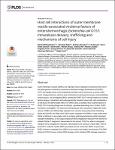Host cell interactions of outer membrane vesicle-associated virulence factors of enterohemorrhagic Escherichia coli O157: Intracellular delivery, trafficking and mechanisms of cell injury
Bielaszewska, Martina
Rüter, Christian
Bauwens, Andreas
Greune, Lilo
Jarosch, Kevin-André
Steil, Daniel
Zhang, Wenlan
He, Xiaohua
Lloubes, Roland
Fruth, Angelika
Kim, Kwang Sik
Schmidt, M. Alexander
Dobrindt, Ulrich
Mellmann, Alexander
Karch, Helge
Outer membrane vesicles (OMVs) are important tools in bacterial virulence but their role in the pathogenesis of infections caused by enterohemorrhagic Escherichia coli (EHEC) O157, the leading cause of life-threatening hemolytic uremic syndrome, is poorly understood. Using proteomics, electron and confocal laser scanning microscopy, immunoblotting, and bioassays, we investigated OMVs secreted by EHEC O157 clinical isolates for virulence factors cargoes, interactions with pathogenetically relevant human cells, and mechanisms of cell injury. We demonstrate that O157 OMVs carry a cocktail of key virulence factors of EHEC O157 including Shiga toxin 2a (Stx2a), cytolethal distending toxin V (CdtV), EHEC hemolysin, and flagellin. The toxins are internalized by cells via dynamin-dependent endocytosis of OMVs and differentially separate from vesicles during intracellular trafficking. Stx2a and CdtV-B, the DNase-like CdtV subunit, separate from OMVs in early endosomes. Stx2a is trafficked, in association with its receptor globotriaosylceramide within detergent-resistant membranes, to the Golgi complex and the endoplasmic reticulum from where the catalytic Stx2a A1 fragment is translocated to the cytosol. CdtV-B is, after its retrograde transport to the endoplasmic reticulum, translocated to the nucleus to reach DNA. CdtV-A and CdtV-C subunits remain OMV-associated and are sorted with OMVs to lysosomes. EHEC hemolysin separates from OMVs in lysosomes and targets mitochondria. The OMV-delivered CdtV-B causes cellular DNA damage, which activates DNA damage responses leading to G2 cell cycle arrest. The arrested cells ultimately die of apoptosis induced by Stx2a and CdtV via caspase-9 activation. By demonstrating that naturally secreted EHEC O157 OMVs carry and deliver into cells a cocktail of biologically active virulence factors, thereby causing cell death, and by performing first comprehensive analysis of intracellular trafficking of OMVs and OMV-delivered virulence factors, we provide new insights into the pathogenesis of EHEC O157 infections. Our data have implications for considering O157 OMVs as vaccine candidates.
Dateien zu dieser Publikation
Keine Lizenzangabe

